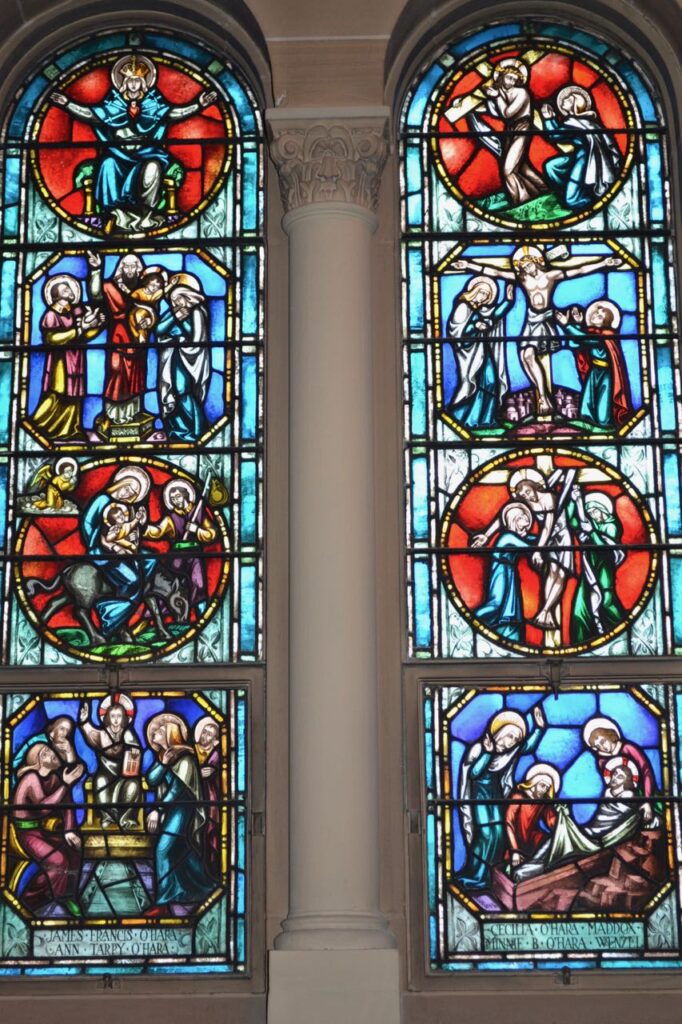
The Passionists, who founded St. Joseph’s Monastery Parish, had a particular devotion to Mary as the Sorrowful Mother. The windows at the Mary altar depict the Seven Sorrows of Mary and September 15 is dedicated to this memorial of her life. The upper left image depicts Mary, seated as Queen of Heaven, with seven swords piercing her heart. Her arms are outstretched, like those of her son nailed to the cross, embracing the world. Jesus’ death on the cross was the culmination of the sorrow Mary experienced throughout her life. The remaining images portray the specific seven sorrows which the swords represent.
The first three sorrows involve Jesus as a child. At the Presentation of Jesus in the Temple, just after His birth, Simeon took Him in his arms and prophesied, to Mary, that Jesus would be “…a sign that would be contradicted (and you yourself a sword will pierce)…” Lk 2:34-35. Hand gestures are very important in the images in these windows. Simeon’s right hand is raised with two fingers and his thumb extended and the other two fingers curled under. In Christian art this is a sign of blessing. The three fingers represent the Trinity and the two, that Jesus is both God and man. Jesus hands are open to receive the blessing and Mary’s hands clutch her cloak as if seeking protection.
The second sorrow is the Flight Into Egypt. The terror of their flight is suggested by the donkey’s lowered head. Now Jesus’ right hand is raised in the gesture of blessing, but His left hand reaches to Joseph for protection and Joseph’s hand enfolds it in reassurance. The Angel intercedes for God to protect them. Mary surely felt sorrow on this journey for the massacre of the innocent children that Herod had killed in an attempt to kill Jesus, who he deemed was a threat to his throne.
The third sorrow is Mary’s three days separated from her son before Finding the Child Jesus in the Temple. Losing a child is heart wrenching. Separation from the Son of God must have been agony. In this image, Jesus’ right hand is raised in the same gesture of blessing. While some hand gestures have a consistent interpretation in Christian Art, other gestures give meaning to the scene depicted. Here that is true as the teachers ponder what He says. Open hands often symbolize acceptance and here we see that sign of acceptance in the teacher in the foreground and in Mary’s open left hand. Her right hand again suggests her need for protection in this bewildering situation.
The remaining four sorrows occurred as Mary participated in the Passion and Death of her Son. As Mary Meets Jesus on the Way to Calvary, her folded hands are similar to those of the Angel who was praying for their protection on the way to Egypt, suggesting her supplication for her Son in his suffering. At the Crucifixion, we see Jesus’ right hand extended in blessing, even as it is nailed to the cross, and Mary and John beneath the cross receiving that blessing, even though they cannot yet understand it. In this image, Mary’s need for protection has been replaced by her complete confidence in God in this moment. As Jesus is Placed in Mary’s Arms, His arms are extended as if to embrace His Mother who receives Him. As Jesus is Laid in the Tomb, Mary’s right hand is raised with the index finger pointing up, directing our attention to God, whose work this is, and her left hand is raised in a gesture of praise. Even in her own suffering, fear, and pain at the death of her son, Mary’s heart was centered in God.
These windows remind us that in the midst of the struggles and sorrows of our own lives, Mary has gone before us and is a source of strength. She intercedes for us and reminds us that God is present with us as He was with her. May we grow in our understanding of Mary’s role in God’s plan for our salvation and may we turn to her, asking her to intercede for us, in our need, before her Son.